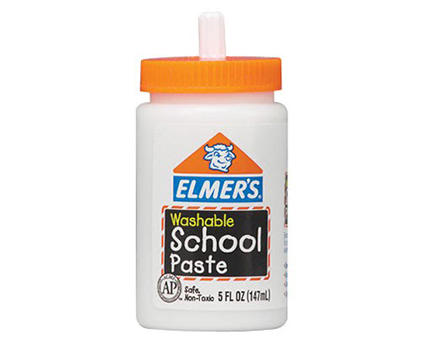
Section Branding
Header Content
Was it ok to eat paste as a child?
Primary Content

White, creamy, sweet… with just a hint of mint. Got you going yet? I'm not surprised there are plenty of tasty things that fit that description. What I am here to talk about isn't Junior Mints or Oreos… It's paste, which for some of you might bring back fond, flavorful memories.
If you ate paste as a child you probably know now that it wasn't too big of a deal. In fact, the deck was stacked against you as paste is, for the most part, just flour and sugar. It isn't all sunshine and rainbows with paste, though, there are a few ingredients that you shouldn't really be eating. How about this…Let's break down paste and then see what we can do to recreate the wide-eyed childhood joy of ingesting adhesive.
Paste is a combination of ingredients that are either right in front of you or easy to obtain.
Library Paste:
1 Cup Flour
1 Cup Sugar
4 Cups Water
1 tsp. Alum
30 drops of clove oil
Flour, sugar, water… that seems no more dangerous than pizza crust or pasta (wait for it). Lets talk about the last two ingredients. Alum is used in paste for a couple reasons.
Alum keeps moisture out:
If you use an anti-persperant you probably slather yourself in alum all the time. Alum helps the paste dry. Perhaps it works too well for this as I remember paste being a clumpy, unwieldy mess when I tried to use it as a kid.
Alum makes your whites whiter:
There was a point in time when alum was used to make bread white. I will admit this is conjecture on my part but I think it is safe to assume that alum makes that tasty paste an even more enticing shade of white.
Alum shows up in food (like pickles) but not that much -- not the safest thing to eat in large doses either. Alum also irritates your mucous membranes. Spoiler alert: your mouth is a mucous membrane. Let's remove alum from our recipe.
So about that clove oil. Cloves are wonderful, you say. I could go for some mulled wine right now, you think. Why is there clove oil in paste?
Clove is an insect repellant:
The recipe we are breaking down is more for book binding than macaroni pictures. There are insects (like the silver fish) that love a good book binding. In fact they enjoy book bindings for the same reason you liked paste as a kid, sugar. Clove is an irritant and has a pretty heavy smell that insects are not fond of.
Anti-Fungal properties.
Clove oil has anti-bacterial and anti-fungal properties. Paste is essentially a dough and will mold if not preserved. Clove and alum together attempt to keep your book spine from sprouting spores.
Clove doesn't sound nearly as bad as alum but pure essential oils are pretty concentrated and can easily make you sick. Clove like alum irritates mucous membranes. The 30 drop concentration in this paste recipe is a bit too much for human consumption. We can't get rid of the clove oil all together though as this essential oil is part of the magic of paste. I am sure we can figure something out.
There is a strong chance that most people grew up eating Elmer's school paste or some variant there of. The key difference is that Elmer's paste uses spearmint oil not clove oil. Spearmint has some of the properties of clove but is not quite as strong. Perfectly suited for poorly constructed popsicle stick houses.
We have water, flour, and sugar left in our paste recipe. All we need to do now is replace the water with an egg or two and we turn our paste into pasta, which are just about the same thing… Ok… I will admit that is stretching it a little, but paste and pasta are very similar.
The quick and dirty moral of the story is that if you want to enjoy paste responsibly a quick sprinkle of clove or mint on your next pasta dish could bring back those halcyon days.
YOU HAVE BEEN EATING PASTE YOUR WHOLE LIFE.
It is also very important I say this and look me directly in the blog when I tell you this. Don't eat paste
Secondary Content
Bottom Content





